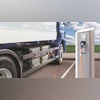)
India transports 4.6 billion tonnes of freight annually, with medium and heavy-duty trucks handling a staggering 97 per cent of all freight movements. | Representational Photo
The Indian economy has a ubiquitous wind in its sail. According to the latest projections, India’s nominal GDP is expected to double to over $7 trillion by FY 2030-31, up from $3.6 trillion in the last fiscal year, making India the third-largest economy in the world. Given India’s position as the fastest-growing large economy, these projections carry significant weight and promise.
India’s economic ambitions are further strengthened by its commitment to ensuring this growth is sustainable by reducing CO₂ emissions by one billion tonnes and lowering carbon intensity by 45 per cent by 2030, ultimately paving the way to achieving a net-zero emissions target by 2070. India’s unwavering commitment is demonstrated through its notable achievement of having the fastest pace of renewable capacity addition among all major economies.
India’s net-zero carbon strategy has focused intensely on sectors such as automotive, power, steel, aviation, cement, and agriculture, which collectively contribute significantly to India’s carbon emissions. This focus is crucial, as India is the third most polluted country in the world. In 2019, pollution claimed 1.67 million lives and resulted in economic losses of $36.8 billion due to premature deaths and morbidity.
Decarbonising the trucking sector
A major portion of this pollution, accounting for about 12-14 per cent of CO₂ and particulate emissions, comes from diesel-powered heavy commercial vehicles. India transports 4.6 billion tonnes of freight annually, generating 2.2 trillion tonne-kilometres, with medium and heavy-duty trucks handling a staggering 97 per cent of all freight movements.
Despite representing just 3 per cent of the total fleet (both passenger and freight vehicles), trucks are responsible for 53 per cent of particulate matter emissions. With the number of trucks expected to increase from 4 million in 2022 to over 17 million by 2050, it is both environmentally and economically essential to accelerate the scaling up of Zero Emission Trucks (ZETs).
Furthermore, relying solely on conventional trucks to meet India’s growing demand would require over $1 trillion in cumulative spending on crude oil imports for diesel production by 2050. There is, therefore, a compelling case for decarbonising the trucking industry using sustainable alternatives, such as battery-electric trucks (BETs) and fuel-cell electric trucks (FCETs). Studies estimate that scaling up ZETs could reduce cumulative trucking particulate matter (PM) and nitrogen oxide (NOx) pollution by around 40 per cent by 2050. This would translate into 2.8–3.8 gigatonnes of cumulative CO₂ savings, equivalent to or greater than India’s entire annual greenhouse gas emissions today. The incremental health and environmental benefits make reducing pollution the primary driver of e-mobility.
However, the transition to ZETs faces challenges. The high cost of ZETs — at 2 to 6 times the cost of diesel trucks — is one such challenge. Performance is also hindered by the widespread practice of overloading trucks in India. Additionally, ZETs place significant demands on the electricity transmission and distribution networks and encounter reluctance from Indian truck manufacturers, who operate with narrow profit margins and are hesitant to invest in alternative fuel technologies.
Government initiatives and industry response
To meet the target of electric trucks making up at least 79 per cent of the total trucking fleet for India to achieve net-zero by 2070, several initiatives are in progress. At the national level, NITI Aayog’s e-FAST (Electric Freight Accelerator for Sustainable Transport) is actively facilitating collaboration between government stakeholders, private sector partners, and global non-profit organisations such as the Smart Freight Centre (SFC) to accelerate the electrification of freight in India. SFC India has been conducting ZET Enablement Workshops — the latest in Hyderabad — to address the technological, operational, financial, and policy challenges hindering ZET adoption.
Commendable efforts are also being made at the state level. Telangana, for instance, is the first Indian state to commit to the Global Drive to Zero Memorandum of Understanding, aiming to transition 30 per cent of new medium and heavy-duty truck sales to electric by 2030, and 100 per cent by 2040, as pledged at COP26. Telangana’s dedication to sustainable transport is evident in the successful implementation of its Electric Vehicle and Energy Storage Systems Policy, which has seen electric vehicle penetration rise from 0.2 per cent to 6 per cent since its launch in 2020. The establishment of the Telangana Mobility Valley (TMV) represents a significant step towards creating a comprehensive electric vehicle ecosystem, with an ambitious investment of Rs 50,000 crore over the next five years, positioning the state as a global leader in sustainable mobility innovation.
Looking to the future, a key focus of Telangana’s vision is prioritising Zero Emission Trucks. Recognising their essential role in reducing emissions and ensuring cleaner air for its citizens, TMV launched the Telangana ZET Accelerator initiative, which brings together stakeholders from across sectors to implement ZET pilot projects throughout the state.
The recently launched PM Electric Drive Revolution in Innovative Vehicle Enhancement (PM E-DRIVE) scheme, with an outlay of Rs 10,900 crore, is another commendable initiative. More such schemes are needed to offer purchase subsidies, interest subventions, dedicated insurance products, scrappage incentives, and long-term contracts for ZETs, as India’s trucking sector is dominated by small fleet operators and individual truck owners. Strict regulations on emissions standards will also be crucial in helping India achieve its 2070 net-zero target.
There is no doubt that ZETs will become increasingly viable as supportive regulatory frameworks, financial incentives, and infrastructure development bring economies of scale and create a robust ecosystem.
(The author is Director of Automotive and EV sector, Industries and Commerce Department, Govt. of Telangana)
Disclaimer: These are personal views of the writer. They do not necessarily reflect the opinion of www.business-standard.com or the Business Standard newspaper
First Published: Sep 30 2024 | 3:13 PM IST


































